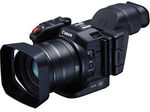Great price for a serious video camera. I've been considering one for a while and this price makes it the cheapest I've ever seen it by a long shot (including overseas grey imports).
The Canon XC10 4K Camcorder has pro UltraHD 4K video capability, and is produced in body ergonomically designed for handheld use and easy portability. The camera incorporates a 10x optical zoom lens with full manual and auto focus abilities. The Ultra HD 4K recording in a small form factor is possible by using a 1" CMOS sensor that is feeds into a DIGIC DV5 processor. With a total resolution of 4224 x 3164, it is also able to capture video up to 3840 x 2160 and 4:3 photos in up to 12MP. The 8.9 to 89mm lens yields a 35mm equivalent focal length of 27.3 to 273mm in video mode and 24.1 to 241mm in the 4:3 photo modes.
For those who would rather not grade in post: Wide DR Gamma yields wide dynamic range by suppressing brightness while maintaining gradations but is designed to produce finished-looking images without requiring any color grading in post-production 100 to 20,000 ISO Range With a wide ISO range of 100 to 20,000 - coupled with iris and shutter speed control - the XC10 is able to electronically adjust to a range of lighting conditions, from broad daylight to dimly lit rooms. For those more experienced in the video world, there is also the option to use gain values rather than ISO. Gain can be set in the range of 0 to 42dB. To help avoid excessive noise, limits can be defined for both gain and ISO when using auto exposure modes 3" LCD Display For monitoring, playback, and menu access, the XC10 features a 3", 1,030,000-dot LCD. It features a full 100% coverage so there will be no worries about pesky boom mics or other protrusion creeping into the edge of a shot unnoticed. The screen is capacitive-touch sensitive allowing you to access settings that do not have dedicated buttons provided CFast and SD Card Slots For every day photo and video capture (up to 1080p), there is an SDHC/SDXC card slot. An SD card can also be used to store user customizations. To accommodate the up to 305 Mbps that 4K video capture requires there is a separate CFast card slot 720p High Framer ate Recording Capture either 100 fps for PAL area or 120 fps for NTSC area to create slow-motion effects. These high-speed frame rates are recorded in either 35 or 50 Mbps Ergonomic Design with Tilting Grip You can always mount the XC10 to a tripod or other stabilization device, but it is designed to be comfortable handheld as well. The handgrip features a photo/video mode selection toggle, record start/stop button, and exposure rotary all accessible by index finger for easy one-handed operation. The grip also tilts up to 90-degrees, helping you to shoot from high or low angles SLR-Style Lens Operation The 10x optical zoom lens features dedicated focus and zoom rings, providing the feel of a typical DSLR lens






Note the misleading 1" sensor is not actually 1" in any of its dimensions. It's an oddly named "1 inch type" sensor which is about 0.63 inches diagonally if my maths is correct. It gives a 3x crop factor when comparing to full frame.